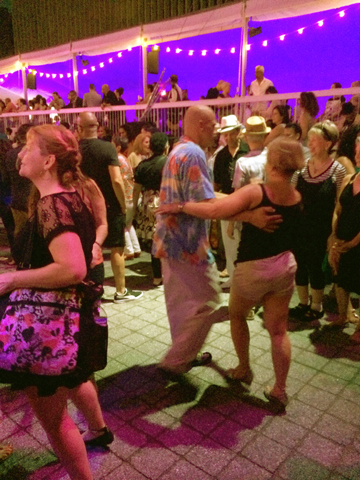Dance: Midsummer Night Swing
By Dawn Lille
ART TIMES online August 2015
To be out of doors during a NYC summer evening is an adventure in seeing and hearing and it is possible to attend a variety of performances all over town, both free and paid. Midsummer Night Swing in Damrosch Park at Lincoln Center is one that seems to create a community among those present and is quintessential New York.
This year it began on June 30 and continued, Tuesday though Saturday evenings, for three weeks, with a different band and dance form each night. Styles were swing, rock n’ roll, disco, rhythm and blues, mambo, New Orleans traditional jazz, funk, soul and tango.
 The Salsa photo credit: Manuel de la Nuez. |
Some people just sit in the park listening to the music, others bring their own chairs and refreshments. Many dance wherever there is a clearing or along the side of the large enclosed stage set up in front of the bandshell, both of which are lit. There are also twinkling colored lights throughout. All are uhit4ed by the concept o listening to the music and moving, if they wish.
To dance on the smooth floor in front of the stage and orchestra costs $17. A six dance pass is $84, a four dance is $60 and a season pass (16 entries) $170. This includes a groups dance class from 6:30 to 7:15. The orchestra plays from 7:30 to 8:30 and from 9:00 to 10:00, with a DJ in between for continuous dancing.
Friday, July 10, was salsa night. The music created one huge group of all ages, colors and shapes, with a large Caribbean representation. People cam e in groups – families, neighbors, couples, singles. Many of the men wore jaunty, light colored panama hats. The women’s clothing ranged from long dresses to shorts with lacy tops and carefully chosen jewelry.
A five by five woman, who could have been a grandmother, started dancing with a man a bit younger. Suddenly the music possessed her and she was transformed. This was taking place outside of the official dance floor, which was slightly raised and fenced. In this area there were a number of small dance floors, purposeful openings in the constant flow of people. Sometimes a man on one side would ask a woman on the other to dance, they would create a vortex of their own making, and at the end of the number part.
The dancing was smooth and the subtle movements never stopped, although some of the younger dancers displayed more elaborate steps and breaks. Watching one corner of the dance floor, which we quickly dubbed “the old folks section,” a tall, thin, white haired man wearing a small white panama hat and a blue shirt unbuttoned almost to his waist, seemed not to move at all as he carefully led his partner into in and out curves. But then you were aware that the rhythm never stopped pulsating in his body and he glided seamlessly across the space.
Looking at some couples you sensed that they had danced together often; others communicated that they had been moving to this music all their lives. The entire park was packed with dancing to soft salsa and the singing of the popular Dominican dubbed “El Canario,” who was celebrating four decades of a romantic voice.
 The Lindy photo credit: Manuel de la Nuez. |
The next night was the closing even of the series. It featured the Harlem Renaissance Band, a 17- member ensemble of seasoned musicians who played selections going back to the Savoy Ballroom and coursing through the height of the swing era, with a tribute to Illinois Jacquet.
The dance lesson was the lindy hop, a style that was heavily influenced by the Charleston, which, in turn, had antecedents in African dance. In its outgoing exuberance, it created a different kind of excitement from the previous evening.
There were few beginners here. Some of the more experienced dancers of all ages took part in the lindy contest. Held under the gaze of five judges, it was a throw back to the contests held at the Savoy. The winning couple received the Ambassador Prize, in honor of Frankie Manning, the late Savoy dancing legend.
These contestants wore elaborate outfits and surely reminded some of the other elegantly dressed dancers of their own younger dancing days in Harlem. One gentleman was dressed in orange, hat included. There was a young couple that exuded a flowing rhythmic delight in their low-keyed and beautifully executed syncopated movements.
These evenings are fun whether one listens, looks or participates. All become friends with those around them in the magic aura of music and movement on a New York summer night.
dawnlille@aol.com
